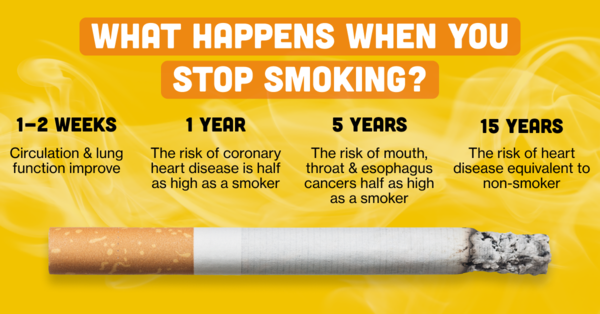With more than 7,000 chemicals released every time you light a cigarette, it’s no wonder that smoking ranks among the leading causes of preventable deaths globally. Despite this, approximately 1.3 billion people worldwide actively smoke. But what exactly happens when you quit smoking?
Within the first 20 minutes of quitting, your blood pressure and heart rate start to return to normal. This occurs because the nicotine in cigarettes triggers the release of epinephrine and norepinephrine, which elevate heart rate and constrict blood vessels. These effects often lead smokers to experience colder extremities, but within this short time frame, hands and feet return to their normal temperature.
After about 2 hours, nicotine cravings kick in, leading to mood swings, drowsiness, tension, and even difficulty sleeping. This is because nicotine increases dopamine release, resulting in these expected physiological responses as nicotine levels decrease.
Eight hours post-quitting, inhaled carbon monoxide clears from the bloodstream, allowing oxygen levels to normalize. Carbon monoxide competes with oxygen to bind to hemoglobin, which stretches the circulatory system. As carbon monoxide clears, there’s more room for oxygen, alleviating strain on the cardiovascular system. However, long-term smokers may experience increased blood pressure and blood clot risks due to chronic carbon monoxide exposure.
Also read - Vape vs. Cigarette
Surprisingly, 24 hours after quitting, coughing may increase as the body works to expel toxins from the lungs. This marks a decrease in the risk of developing coronary artery diseases.
At the 48-hour mark, nicotine and its metabolites are completely eliminated from the body, leading to the regeneration of damaged nerve endings. Taste buds, which were flattened and had fewer blood vessels due to cigarette chemicals, start to regain sensitivity, enhancing the enjoyment of food.
By the 72-hour mark, nicotine withdrawal symptoms peak, including headaches, nausea, cramps, anxiety, and depression. However, this phase passes, and after one month, the risk of type 2 diabetes, cancer, and cardiovascular diseases decreases significantly.
Between three to nine months, damaged cilia in the lungs, which help clear debris, are nearly fully repaired, reducing symptoms like coughing and shortness of breath. Around the one-year mark, the risk of heart disease from arterial blockages decreases by almost half.
Over a decade, the chance of developing lung cancer halves compared to continuing smokers, and in 15 years, the risk of heart attack equals that of someone who has never smoked.
While individual recovery varies based on smoking habits, quitting yields substantial health benefits, despite some irreversible lung damage. Remember, prevention is key, and avoiding smoking altogether is the best approach.

